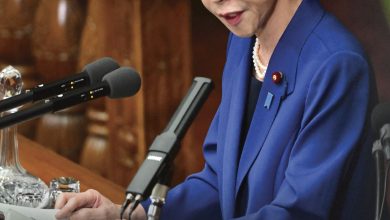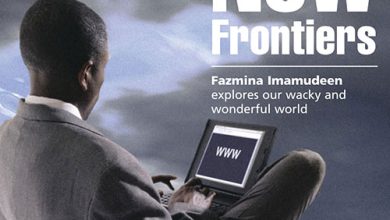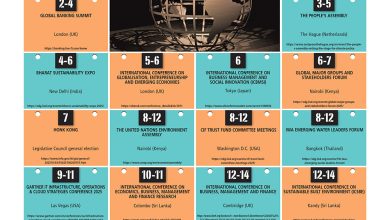NEW FRONTIERS
 VERIFIABLY HUMAN In a glass walled space off San Francisco’s Union Square, there’s not much to see – only a few chairs, some staff and a polished metal orb that scans your eyes.
VERIFIABLY HUMAN In a glass walled space off San Francisco’s Union Square, there’s not much to see – only a few chairs, some staff and a polished metal orb that scans your eyes.
It belongs to the World Network (formerly Worldcoin) and is OpenAI CEO Sam Altman’s attempt to build a global digital identity system. There’s no checkout, products or noise… only a single proposition: prove you are human.
The logic is simple. As AI generated content floods the internet and bots grow harder to spot, World wants to offer a kind of passport – one that’s linked to your iris. The scan creates a unique cryptographic identity stored on the blockchain and it’s called a World ID. At this time, you need an appointment to get one.
It sounds like sci-fi but the mood inside the store is more startup demo than tech utopia. World wants this ID to be used across platforms and borders. A smaller Orb Mini is already in development.
But doubts haven’t disappeared because the scans aren’t always smooth and the privacy trade-offs are unclear. And handing over your biometric data to a private entity still raises more questions than provides answers.
Nevertheless, the objective is clear: in a world filled with fakes, being verifiably human might soon be the only real value left.
PREMIUM SEATS In Inglewood, California, a new type of venue is quietly reshaping how we experience live sports. Cosm’s dome-shaped theatres aren’t stadiums – and they don’t need to be.
Inside, a 26 metre diameter 8K LED screen wraps around the audience and blends ultra-high-resolution visuals with spatial audio to create what the enterprise calls ‘shared reality.’ The goal is to make you feel like you’re right there at the game – even if the event is happening far away.
Originally designed for planetariums, this technology has been repurposed for sports, concerts and even cultural shows. So far, Cosm has partnered with major leagues such as the NBA to broadcast live matches in a way that merges physical presence with digital immersion.
Think of it as the halfway point between a stadium and VR headset. It’s a social, immersive and refreshingly screenless experience.
With venues now open in Los Angeles and Dallas, and more on the way, Cosm is betting on a future where people still want to gather but expect more from the experience. In an age of personal feeds and private screens, it’s a reminder that some things such as cheering in sync with strangers feels better together.
TRUST DEFICIT In this era of deepfakes, AI generated resumes and convincing voice clones, it’s becoming harder to answer this simple question: ‘Is this person real?’
Take Detroit based PR professional Nicole Yelland, who thought she was speaking to a legitimate recruiter because the job looked real, as did the LinkedIn profile. But the entire conversation was fake – an elaborate social engineering scam that cost her time, emotional bandwidth and trust.
Since then, she’s adopted a new protocol: background checks, language tests and even verifying a person’s geographic knowledge before continuing a conversation.
Yelland’s experience is no longer unusual. From 2020 to 2024, job related scams reported to the US Federal Trade Commission (FTC) nearly tripled. Losses jumped from US$ 90 million to over 500 million dollars.
The remote work era combined with rapid AI advancements has created the perfect storm for fraud. Platforms built on professional credibility such as LinkedIn are now prime targets for identity manipulation.
Meanwhile, startups such as GetReal Labs are stepping in, and building biometric verification tools and AI detection systems. But until these safeguards are widespread, professionals are relying on an older playbook – instinct, caution and a little paranoia.
The cost is that trust has become a liability. In trying to stay safe, we risk losing the ease of connection that made the digital world worth showing up for.
ROOTS OF RETURN In the far south of Texas where highways slice through farmland and strip malls, Jon Dale – a director of American Forests – is trying to bring back a forest, which most people don’t even know existed.
The Rio Grande Valley was once home to over a million acres of tamaulipan thorn forest – dense spiny brushland that’s teeming with life and stretching across the US border with Mexico. Today, less than 10 percent of that habitat remains as it has been cleared over decades for citrus, cotton and concrete.
But lifelong birder Dale has made it his mission to reverse the loss.
It began with less than a hectare. At the age of 15, he began planting native seedlings outside his home – plants no one sold and species no one talked about. Two decades later, Dale is leading reforestation efforts across the region. The goal is to also rebuild an entire ecosystem.
Restoring the thorn forest means bringing back habitats for endangered species such as the ocelot, improving flood resilience and building the foundations for ecotourism in an area that’s long been overlooked.
It’s slow work because some saplings die while others take years to grow a few feet. But Dale’s vision is patient and rooted, both literally and philosophically, in the belief that landscapes – like people – can recover with time and care.





